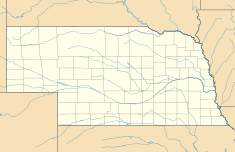Cooper Nuclear Station
| Cooper Nuclear Station | |
|---|---|

The reactor complex on June 15, 2011 during the 2011 Missouri River Floods
|
|
| Country | United States |
| Location | Nemaha County, near Brownville, Nebraska |
| Coordinates | 40°21′43″N 95°38′29″W / 40.36194°N 95.64139°WCoordinates: 40°21′43″N 95°38′29″W / 40.36194°N 95.64139°W |
| Status | Operational |
| Commission date | July 1, 1974 |
| Owner(s) | Nebraska Public Power District (NPPD) |
| Operator(s) | NPPD with Entergy support services |
| Nuclear power station | |
| Reactor type | boiling water reactor |
| Reactor supplier | General Electric |
| Power generation | |
| Units operational | 1 × 770 MW |
| Capacity factor | 88.4% (2008) |
|
Website www.nppd.com/.../cns |
|
Cooper Nuclear Station (CNS) is a boiling water reactor (BWR) type nuclear power plant located on a 1,251-acre (506 ha) site near Brownville, Nebraska between Missouri River mile markers 532.9 and 532.5, on Nebraska's border with Missouri. It is the largest single-unit electrical generator in Nebraska.
CNS is owned and operated by the Nebraska Public Power District (NPPD), a political subdivision of the state of Nebraska. Management support services for Cooper Nuclear Station is provided by Entergy Nuclear, the nation's second largest nuclear power operator.
The facility is named after Humboldt natives Guy Cooper, Jr., and Guy Cooper, Sr. The senior Cooper's father, O. A. Cooper, built the first electrical plant in Humboldt in 1890; the two Guy Coopers served a total of 27 years on the board of NPPD and its predecessor agency, Consumers Public Power District.
CNS was first put into operation in July 1974 and generates approximately 800 megawatts (MWe) of electricity. The plant consists of a General Electric BWR/4 series reactor plant and a Westinghouse turbine generator. The plant has a Mark I containment system.
In 1998, CNS was the first plant in the United States to load nuclear fuel containing uranium that had been provided under the Megatons to Megawatts Program, in which uranium removed from nuclear weapons of the former Soviet Union was turned into low-enriched uranium and then into fuel.
...
Wikipedia

